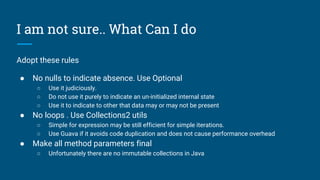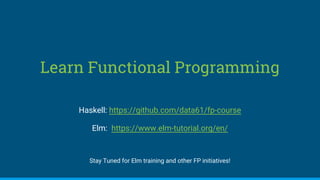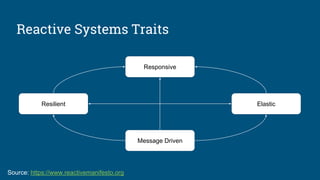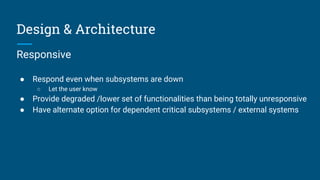Functional Programming 101 for Java 7 Developers
- 1. Beyond null & more Taming the monsters, the right way! [email protected]
- 3. It must be some kind of race condition!!!
- 6. Functional and Reactive Programming 101 for Java 7 Developers
- 7. What will you get? ● Get started with basic Functional Programming principles ● Reactive System Design ● Adopt in your day to day work from now!
- 8. Functional Programming Intro ● Function ○ y = f(x) ● Functions as ‘First Class’ Citizens ○ Similar to values ○ Pass to / return from other functions ● Separate Data from Functions ○ Data is passed to functions ○ Data may be returned from functions ○ State Management outside of Functions Programming with Functions
- 9. Functional Programming Facets ● Pure Functions ○ No Side Effects ○ Referential Transparency ● Immutable Data Structures ● Expressive Power ○ Ability to Reason - Equational Reasoning ○ Function Composition ■ f : b -> c , g : a -> b ■ f o g : a -> c ● f o g = f(g(x))
- 10. Pure Functions ● No side effects , including IO ○ For a set of inputs, always produce the same output ● Referential Transparency ○ Can ‘inline’ the function everywhere with no changes to the behavior ○ Works with substitution model of computation ● Ensures Testability
- 11. Pure Functions Is this a pure function? func increment(int value ) { return value + 1; }
- 12. Pure Functions How about this? func increment(int value ) { if(value < maxVal) { return value + 1; } else { return maxVal; } } func increment(int value, int maxVal ) { if(value < maxVal) { return value + 1; } else { return maxVal; } }
- 13. Pure Functions ..and this too? func increment(int value ) { int newValue = value +1; localStorage.put(“curValue”, newValue); return newValue; } func increment(int value ) { return { “val” : value +1, “task” : { “task” : localStorage, “key” : “curValue”, “val” : value+1 } }; }
- 14. Pure Functions Ignore IO and let’s discuss this func updatePwd(String pwd ) { Node node = nodeFromExternal(); if(node.id == 2) { invokeApi(node,pwd); } } func updatePwd(String pwd , int id) { Node node = nodeFromExternal(); if(id == node.id ) { invokeApi(node,pwd); } }
- 15. Immutability Reference to a data structure is *only* for reading from the data structure Once you have a reference: ● Guarantees that no one will modify its contents ● Pass along to any number of threads without fear of ‘stepping on each other’ ○ Enables safe concurrency and parallelism ● Any updates to the data structure returns a new reference
- 16. Immutability : an Example Defects (holds list of open defects) val defectList = List(Defect(id="CSSid1234",age=48,engineer="jayas"),Defect(id="CSCid5678",age=12,engineer="otherone")) defectList.foreach { defect => if (defect.age > 28) { sendMsg(defect.engineer) } } defectList.dropWhile { defect => defect.engineer == "jayas" } Thread 1 Thread 2 val myDefectList =
- 17. Why Functional Programming Pure Functions ● Guarantees Testability ● Easy Refactoring ● Reduce Defects Immutable Data Structures ● Safe Concurrency and Parallelism ○ Eliminate concurrency / multi-threading defects ○ Enables lock free operations ● Ensures Testability
- 18. Why Functional Programming Expressive Power ● Readability and Maintainability ● Adhering to mathematical laws and principles ● Programming by whole values ○ Lesser Lines of Code , and thus lesser the possibility of defects More Info ● View “Why Functional Programming Matters”
- 19. OOP
- 20. OO - in its Original Form ● State Encapsulation in Objects ● Message Passing for Communication ○ Objects to process messages sent to it ○ Respond by sending messages ● Not intended to use as Data Containers/Holders
- 21. OO - as what we do for living ● Primarily a Data Holder ● No Message Passing - arbitrary retrieval and update of data ● Imperative Programming to the core ○ Manipulating State ○ Instructing Computer on How to Do ● Hard to do Concurrency
- 22. Imperative Vs Functional ● Programming By Word Vs Whole Values ○ No word at a time processing ○ Work with entire value (data structures) ● How to Do Vs What To Do ○ Focus on business logic implementation ○ E.g: No instructions on how to traverse a list ● Less Code that Does more ○ Reduce Lines of Code ○ Reduce Possibility of Defects for(int i=0; i< j; i++) { .... }
- 23. Whole Value Programming map (A ->B) List<A> -> List<B> ● List of agents -> List of agent UserIds flatMap (A -> List<B>) List<A> -> List<B> ● List of agents -> List of extension numbers filter (A->Boolean) List<A> -> List<A> ● Get all supervisors from user list foldl (acc x -> y) x List<x> -> y ● Total talk time from a list of call data records Do a map, filter and fold it!
- 24. map a list of agents to list of strings (using Guava in Java 7) import com.google.common.base.Function; import com.google.common.collect.Collections2; Function<Agent, String> agentTransformer= new Function<Agent,String>() { @Override public String apply(Agent agent) { return agent.getId(); } }; List<String> agentIds = new ArrayList<String>(Collections2.transform(agents,agentTransformer)); Whole Value Programming
- 25. filter a list of agents to list of supervisors (using Guava in Java 7) import com.google.common.base.Function; import com.google.common.base.Predicate; import com.google.common.collect.Collections2; Predicate<Agent> supervisorFilter = new Predicate<Agent>() { @Override public boolean apply(Agent agent) { return agent.role == Role.SUPERVISOR; } }; Collection<Agent> supervisors = Collections2.filter(agents, supervisorFilter); List<String> supervisorIds = new ArrayList<String>(Collections2.transform(supervisors,agentTransformer)); Whole Value Programming
- 26. Strong Static Typing ● Type System and Compiler as First Line of defense ● Reduces dependency on Unit Tests ○ Most of the time, if it compiles, it will run ● Expressive Power By Type ○ e.g: Optional for indicating Value being present or not (vs returning null)
- 27. Strong Static Typing Get rid of null, Now. (using Guava in Java 7) import com.google.common.base.Optional; class Agent { Optional<String> agentAlias; // alias may not may not be set public void setAlias(String alias) { agentAlias = Optional.fromNullable(alias); // alias could be null, Java !! } public Optional<String> getAlias() { return agentAlias; // returns Optional indicating that alias may or may not be there } }
- 28. Strong Static Typing Indicate Error by Type, Later. ( in Scala) def fetchDefectsFromDB() : Try[List[Defect]]= { Try { readFromDB// Get the list from DB } } val defectList : Try[List[Defect]] = fetchDefectsFromDB() defectList.map { defects => defects.foreach {defect => if (defect.age > 28) { sendMsg(defect.engineer)} } } def fetchDefectsWhenDBDown() : Try[List[Defect]]= { Failure(new Throwable(new IllegalStateException("DB Service is not in Running State))) }
- 30. I am not sure.. What Can I do Adopt these rules ● No nulls to indicate absence. Use Optional ○ Use it judiciously. ○ Do not use it purely to indicate an un-initialized internal state ○ Use it to indicate to other that data may or may not be present ● No loops . Use Collections2 utils ○ Simple for expression may be still efficient for simple iterations. ○ Use Guava if it avoids code duplication and does not cause performance overhead ● Make all method parameters final ○ Unfortunately there are no immutable collections in Java
- 31. I am not sure.. What Can I do Adopt these rules ● No Explicit Multi threading / Concurrency ○ For state, in case concurrency is a need, ensure all messages to the object are processed in sequence (yes, sequentially) ○ Use a single threaded executor to handle messages received by an object ● Question and Revisit Impure functions / methods ○ Strictly adhere to Single Responsibility Principle of OO ○ Write pure functions unless it’s unavoidable ○ It’s fine to have a class with all static methods, which are pure! ● Isolate State management and IO to one part of the system ○ Let 80 % of the implementation be pure and stateless
- 32. I am not sure.. What Can I do Adopt these rules ● As Always, there are exceptions to all the rules , check with Architect. ● Performance , Maintainability and Readability are of most importance ○ Do not compromise on these
- 33. Learn Functional Programming Haskell: https://github.com/data61/fp-course Elm: https://www.elm-tutorial.org/en/ Stay Tuned for Elm training and other FP initiatives!
- 34. Architecture & Design Reactive Programming
- 35. Corner cases are Corner Stones in Customer Experience
- 36. Design For Failure - Failures are Inevitable
- 37. Ensure testability at all levels - architecture, design, code
- 38. Reactive Systems Traits Responsive Message Driven Resilient Elastic Source: https://www.reactivemanifesto.org
- 39. Design & Architecture Asynchronous Communication ● Message Passing across components ○ Asynchronous APIs another choice across systems ● Non Blocking IO, Lock Free Operations ○ Use Async Servlet (in Servlet 3.0) for web applications (Shindig is a perfect use case) ○ Use non blocking version of libraries, say http-client, jersey server and client ● Work on Futures and Future Compositions ○ Composition of Futures - not present by default in Java 7 ○ Use ListenableFuture in Guava / CompletableFuture in Java 8 ○ Evaluate and Use RxJava
- 40. Design & Architecture Resiliency ● Build for failures ○ Failures are Inevitable ○ Architecture and Design should facilitate failure propagation and recovery ● Communicate Error & Recover from Failures ○ Let the user know ○ Provide error recovery option ● Retries for inter-component interactions / critical operations ● Location Transparency for distributed/ clustered systems ○ Distributed Cache usage does not rely on fetching cache entry from a particular node
- 41. Design & Architecture Responsive ● Respond even when subsystems are down ○ Let the user know ● Provide degraded /lower set of functionalities than being totally unresponsive ● Have alternate option for dependent critical subsystems / external systems
- 42. Design & Architecture Elastic ● Ability to scale up / down / out / in ○ Build services that caters to 400 users (CCX) , at the same time that can scale for 18000 users (CCE) ○ Utilize all the cores of CPU ○ Ability to add more machines to scale out ■ distributed data processing, location transparency for processing engines
- 44. Additional Learnings Guava Wiki RxJava John Backus’s Turing Award Lecture Learn Functional Programming in Haskell Effects As Data - Talk
- 45. Thank You!










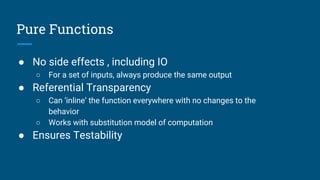


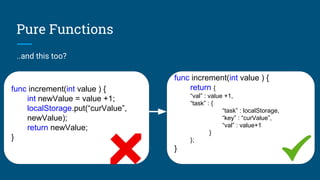
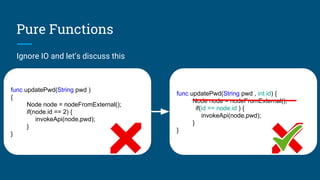





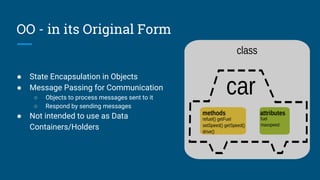





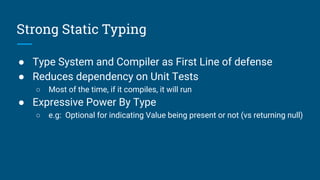

![Strong Static Typing
Indicate Error by Type, Later. ( in Scala)
def fetchDefectsFromDB() : Try[List[Defect]]= {
Try {
readFromDB// Get the list from DB
}
}
val defectList : Try[List[Defect]] = fetchDefectsFromDB()
defectList.map { defects => defects.foreach {defect => if (defect.age > 28) { sendMsg(defect.engineer)} } }
def fetchDefectsWhenDBDown() : Try[List[Defect]]= {
Failure(new Throwable(new IllegalStateException("DB Service is not in Running State)))
}](https://image.slidesharecdn.com/fp101forjava7-170807105441/85/Functional-Programming-101-for-Java-7-Developers-28-320.jpg)

